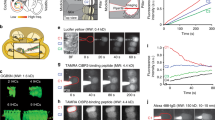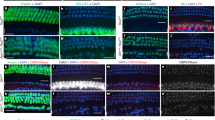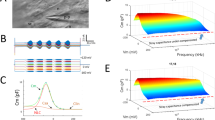Abstract
DISCUSSION about functional differences between the inner and outer hair cells (IHCs and OHCs) in the mammalian organ of Corti1–5, has arisen as a result of several anatomical and electrophysiological observations. The proportions of afferent and efferent fibres supplying the two types of cells are quite different6–8; the afferent neurones associated with them are distinct cytologically as well as in their susceptibility to retrograde degeneration6–8; the electrophysiological responses following preferential loss of OHCs are not what would be expected on the basis of a similarity of function2,5,9–11. Attempts at the elucidation of these differences2,9 have made use of the ototoxic antibiotic kanamycin, which causes preferential damage to OHCs. This technique is far from ideal: the damage may be patchy and IHCs may also be affected. As to the selective elimination of IHCs, no procedure has been available. Mutant genes frequently provide material that cannot be produced experimentally, but although a large number of genes affecting the inner ear in various ways are known in the mouse12–14, there has been none so far that clearly discriminated between IHCs and OHCs. We now report a new mutation in the mouse which selectively eliminates IHCs. As the mutant animals are almost totally deaf, it would seem that hearing is predominantly dependent on IHCs.
This is a preview of subscription content, access via your institution
Access options
Subscribe to this journal
Receive 51 print issues and online access
$199.00 per year
only $3.90 per issue
Buy this article
- Purchase on Springer Link
- Instant access to full article PDF
Prices may be subject to local taxes which are calculated during checkout
Similar content being viewed by others
References
Lynn, P. A. & Sayers, B. McA, J. acoust. Soc. Am. 47, 525–532 (1970).
Dallos, P., Billone, M. C., Durrant, J. D., Wang, C.-Y. & Raynor, S. Science 177, 356–358 (1972).
Evans, E. F. in Facts and Models in Hearing (eds Zwicker, E. & Terhardt, E.) 118–129 (Springer, New York, 1974).
Spoendlin, H. in Facts and Models in Hearing (eds Zwicker, E. & Terhardt, E.) 18–32 (Sringer, New York, 1974).
Nienhuys, T. G. W. & Clark, G. M. Science 199, 1356–1357 (1978).
Spoendlin, H. Acta oto-lar. 73, 235–248 (1972).
Spoendlin, H. in Basic Mechanisms in Hearing (ed. Møller, A. R.) 185–230 (1973).
Spoendlin, H. Boll. ital. Audiol. Fon. 1, 1–23 (1978).
Ryan, A. & Dallos, P. Nature 253, 44–46 (1975).
Dallos, P. & Cheatham, M. A. J. acoust. Soc. Am. 60, 510–512 (1976).
Spoendlin, H. & Baumgartner, H. Acta oto-lar. 83, 130–135 (1977).
Deol, M. S. J. med. Genet. 5, 137–158 (1968).
Deol, M. S. Proc. R. Soc. Lond. B175, 201–217 (1970).
Deol, M. S. in Birth Defects: Original Article Series Vol. 15, (in the press).
Deol, M. S. Genet. Res. 7, 363–371 (1966).
Author information
Authors and Affiliations
Rights and permissions
About this article
Cite this article
DEOL, M., GLUECKSOHN-WAELSCH, S. The role of inner hair cells in hearing. Nature 278, 250–252 (1979). https://doi.org/10.1038/278250a0
Received:
Accepted:
Issue Date:
DOI: https://doi.org/10.1038/278250a0
This article is cited by
-
The neurogenetics of alternative splicing
Nature Reviews Neuroscience (2016)
-
Alternative splicing of inner-ear-expressed genes
Frontiers of Medicine (2016)
-
NCAM in the organ of Corti of the developing mouse
Journal of Neurocytology (1990)
-
A model describing nonlinearities in hearing by active processes with saturation at 40 dB
Biological Cybernetics (1979)
-
Anatomisch-pathologische Aspekte der Elektrostimulation des ertaubten Innenohres
Archives of Oto-Rhino-Laryngology (1979)
Comments
By submitting a comment you agree to abide by our Terms and Community Guidelines. If you find something abusive or that does not comply with our terms or guidelines please flag it as inappropriate.



